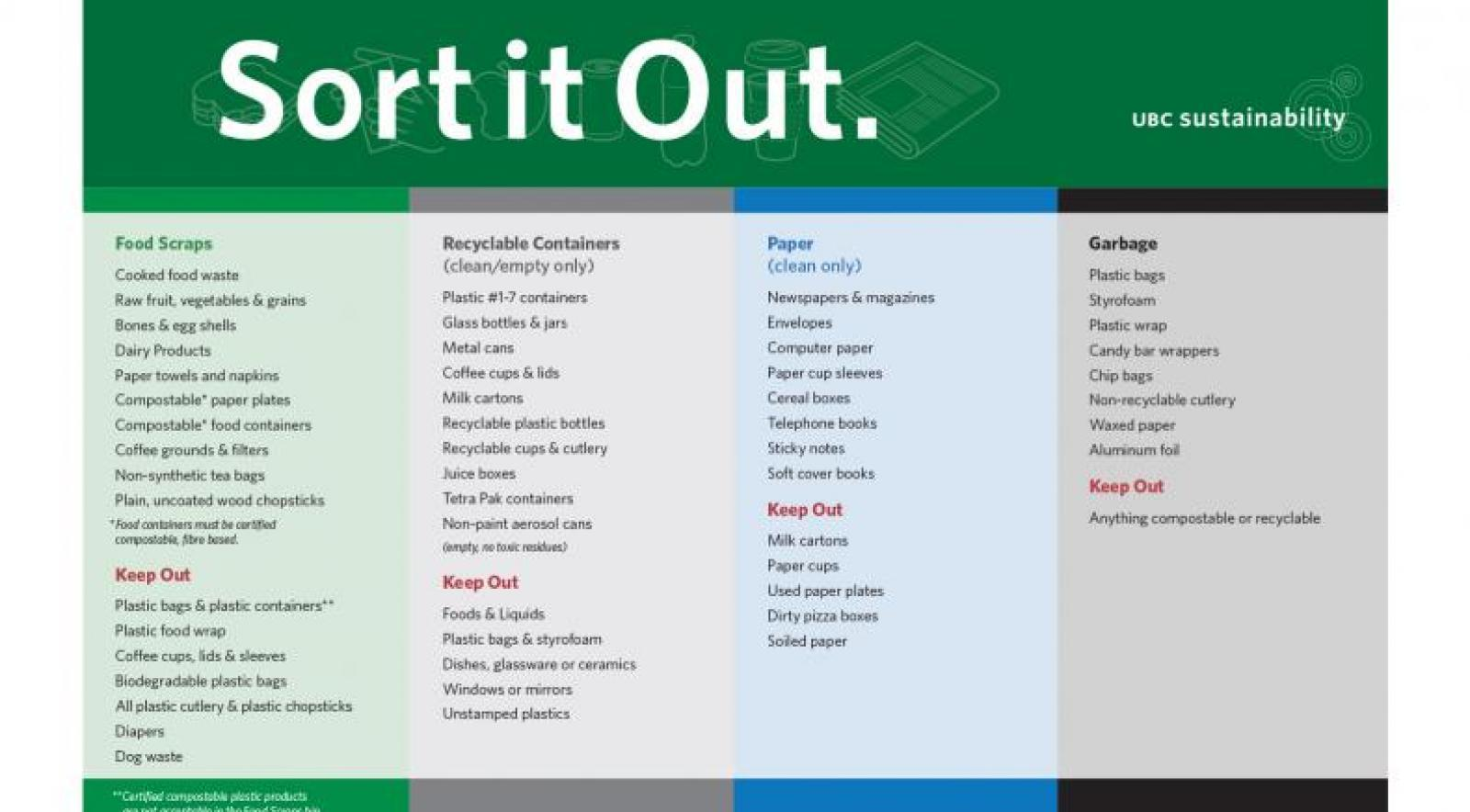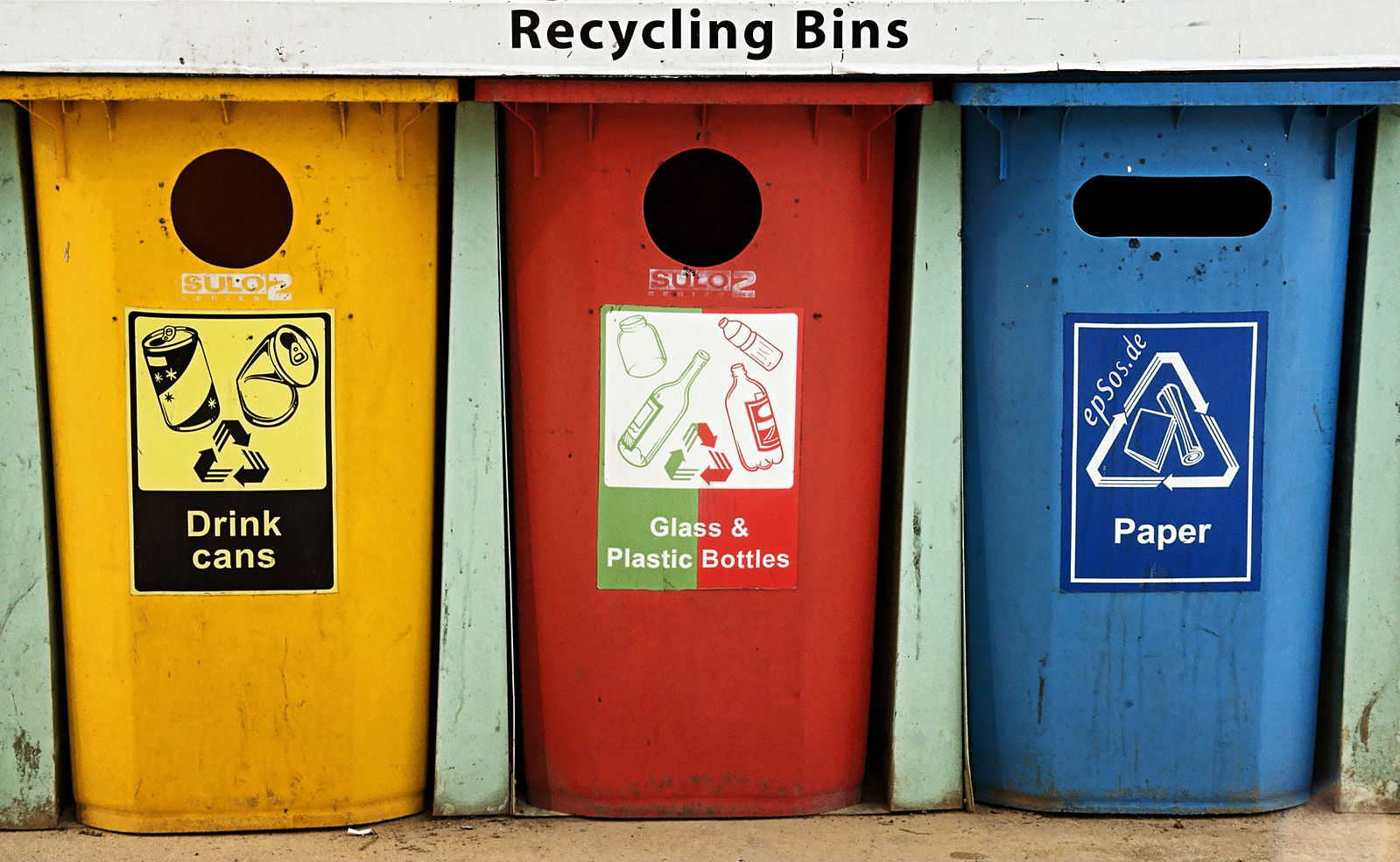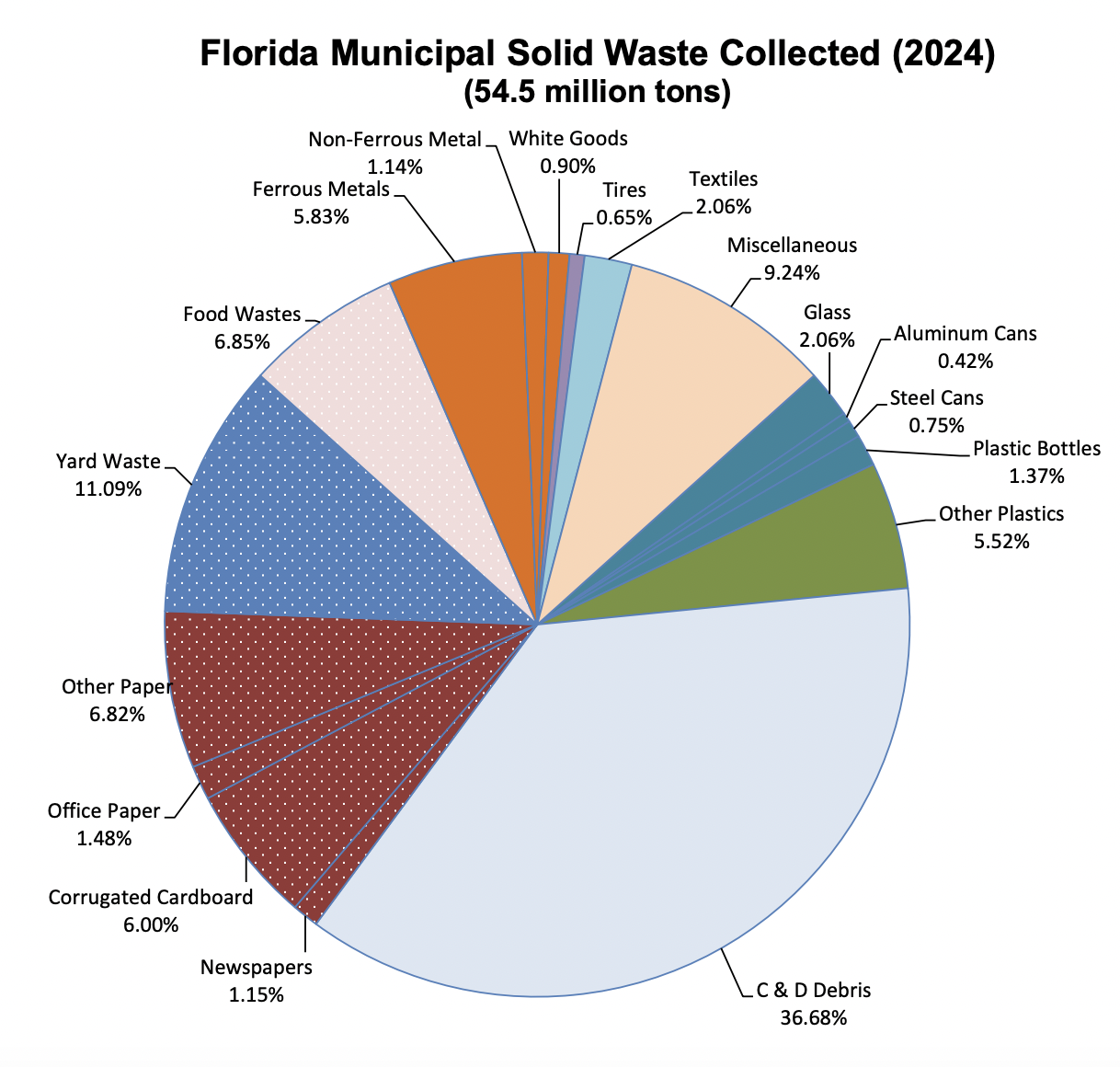IB Syllabus focus:
‘Waste arises from domestic, industrial and agricultural sources; SDW includes paper, glass, metals, plastics, organics, packaging, construction debris and clothing.’
Understanding the sources, types, and contents of solid domestic waste (SDW) is essential for analysing human impacts on the environment, recognising management challenges, and developing sustainable strategies.
Sources of Waste
Domestic Sources
Domestic waste comes from households and includes everyday items discarded by individuals and families. These are often a mixture of organic and inorganic materials.

A picture-based sorting guide illustrating typical household SDW streams—paper, containers (glass, metal, certain plastics), organics, and residual waste. The clean layout and labels reinforce recognition of common materials in domestic waste. Campus-specific branding appears but the categories generalise to household contexts. Source.
Food scraps and organic residues
Paper and cardboard products
Glass bottles and jars
Plastics, including packaging and containers
Textiles, such as worn clothing and fabrics
Domestic waste: Waste generated by households, typically comprising food scraps, paper, plastics, textiles, and other discarded items from daily life.
Industrial Sources
Industrial waste results from manufacturing and processing activities. It can vary widely depending on the type of industry.
Metals and alloys from manufacturing
Plastics and polymers from chemical industries
Packaging from large-scale production
By-products such as ash, sludge, or chemical residues
Agricultural Sources
Agricultural waste originates from farming, forestry, and livestock production. This can include biodegradable and non-biodegradable materials.
Crop residues such as stalks, husks, and leaves
Animal manure and slurry
Pesticide containers and fertiliser packaging
Machinery parts or damaged plastics used in farming
Types of Waste in Solid Domestic Waste (SDW)
Biodegradable Waste
This waste can be broken down naturally by microorganisms. Examples include food scraps, garden waste, and some paper products.
Biodegradable waste: Organic material capable of being decomposed naturally by bacteria, fungi, or other living organisms.
Non-Biodegradable Waste
These materials do not easily break down, creating long-term pollution risks. Plastics, metals, and glass dominate this category.
Hazardous Waste
Some SDW may contain hazardous materials, though in lower concentrations compared to industrial waste. Examples include batteries, electronics, and certain cleaning products.
Recyclable Waste
Recyclable waste includes items that can be processed and reused, reducing the need for raw resource extraction.
Glass bottles
Metal cans
Paper and cardboard
Certain types of plastics

Multi-stream recycling station with clearly marked bins for metals, paper, and plastics alongside residual waste, exemplifying household SDW separation into common material categories. Visual clarity and colour coding support rapid sorting—mirroring categories described in this subsubtopic. Minor site-specific signage is present but does not add content beyond the syllabus scope. Source.
Non-Recyclable Waste
Materials that cannot be economically or technologically recycled, often ending up in landfills or incineration plants.
Household Waste Composition
Paper and Cardboard
One of the largest fractions of household waste, originating from packaging, newspapers, office paper, and cartons. Paper is highly recyclable if not contaminated.
Glass
Includes bottles, jars, and broken glassware. Glass is durable and can be recycled repeatedly without quality loss.
Metals
Mostly aluminium and steel, found in food cans, drink cans, and household products. Metals are valuable recyclables due to their high recovery rate.
Plastics
A diverse category with packaging materials, bottles, bags, and containers. Plastics pose a significant challenge because many types are non-biodegradable and persist in ecosystems.
Organics
Organic household waste consists mainly of food scraps and garden waste. It decomposes rapidly and contributes to methane emissions if not managed properly.
Packaging Materials
Packaging is a significant component of SDW, often combining multiple materials such as plastic, cardboard, and aluminium. Mixed packaging can complicate recycling efforts.
Construction Debris
Includes discarded materials from household renovation and maintenance projects. Examples are wood scraps, bricks, tiles, and plasterboard.
Clothing and Textiles
Discarded garments, shoes, and fabric-based materials form an increasing portion of SDW. Many textiles are synthetic and resistant to natural decomposition.

Municipal solid waste composition in 2024, with labelled fractions for paper, cardboard, plastics, metals, glass, organics, textiles, and construction & demolition debris. This reflects household-influenced SDW streams and corresponds to the material categories discussed in this subsubtopic. Geography-specific percentages are included but the categorical breakdown is the key learning point. Source.
Factors Influencing Household Waste
Socio-Economic Factors
Higher-income households tend to produce more packaging waste due to greater consumption of processed goods. Lower-income households often generate more organic waste from unprocessed foods.
Cultural and Lifestyle Differences
Cultural practices shape waste composition. For example, societies relying heavily on fresh produce may create more organic waste, while fast-food oriented lifestyles contribute to packaging waste.
Technological Development
Increased use of electronics introduces e-waste into domestic streams. Improvements in packaging technology can reduce material use but may complicate recycling.
Environmental Implications
Pollution
When waste is not properly managed, it can lead to air, soil, and water pollution. For example, plastics that enter waterways contribute to long-term ecological damage.
Resource Loss
Unrecycled waste represents lost natural capital, as materials like metals, glass, and paper could otherwise be reused to reduce raw resource extraction.
Public Health Concerns
Improperly managed domestic waste can attract pests, contaminate water supplies, and release harmful chemicals, impacting community health.
Key Characteristics of Household Waste
Diverse composition: A mix of biodegradable and non-biodegradable items.
Volume variability: Influenced by household income, culture, and consumption habits.
Resource potential: Contains significant quantities of recyclable and reusable materials.
Environmental risks: Poor management leads to pollution, loss of biodiversity, and greenhouse gas emissions.
FAQ
Solid domestic waste (SDW) is generated by households and primarily includes everyday discarded items such as packaging, food scraps, and textiles.
Industrial waste, by contrast, comes from manufacturing and processing activities and often contains metals, chemicals, or by-products specific to production.
Agricultural waste is linked to farming and forestry, typically involving crop residues, manure, or containers for pesticides and fertilisers.
Textile waste has increased due to the rise of fast fashion, leading to short product life cycles.
Many modern textiles are synthetic, meaning they are non-biodegradable and persist in landfills.
Additionally, dyes and treatments in fabrics can release harmful substances when improperly disposed of, contributing to environmental pollution.
Renovation and small-scale building projects generate debris often categorised within SDW.
Examples include:
Broken tiles and bricks
Wood offcuts
Plasterboard and cement fragments
Although sometimes recyclable, these materials are frequently mixed with other waste types, complicating separation and disposal.
Packaging often combines multiple materials, such as plastic films bonded with aluminium layers or cardboard lined with wax.
This complicates recycling processes because separating components is costly and technologically demanding.
As a result, much mixed packaging is treated as non-recyclable, increasing landfill or incineration rates.
Uncollected or poorly managed waste can leach chemicals into soil and water.
Plastics can fragment into microplastics, harming aquatic life and entering food chains.
Organic waste, if left unmanaged, can emit methane, a potent greenhouse gas, and attract pests that spread disease.
Practice Questions
Question 1 (2 marks)
Identify two sources of solid domestic waste (SDW) and give one example of waste generated from each source.
Mark scheme:
Domestic/household source identified (1 mark)
e.g. food scraps, paper, plastics, textiles
Correct example linked to domestic source (1 mark)
e.g. leftover food, cardboard packaging, glass bottles
Industrial source identified (1 mark)
e.g. metals, plastics, chemical by-products
Correct example linked to industrial source (1 mark)
e.g. aluminium scraps, plastic pellets, sludge from processing
Maximum: 2 marks (one mark for each valid source + example pair).
Question 2 (5 marks)
Discuss how socio-economic and cultural factors can influence the composition of household waste.
Mark scheme:
Recognition that higher-income households produce more packaging waste due to processed and packaged food consumption (1 mark).
Recognition that lower-income households produce more organic waste from unprocessed foods (1 mark).
Explanation of cultural practices shaping waste (1 mark)
e.g. societies relying on fresh produce produce more organic waste.
Explanation of fast-food or consumer-oriented lifestyles producing more packaging/plastic waste (1 mark).
Any valid further development with a clear example (1 mark)
e.g. electronic waste more common in technologically advanced societies.
Maximum: 5 marks.

